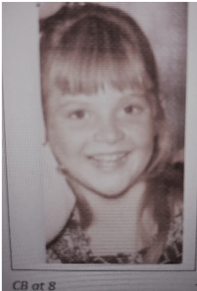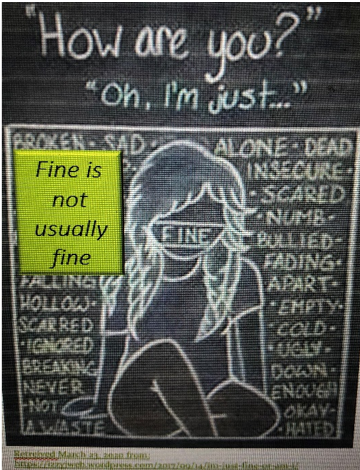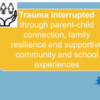As I was considering the children sheltering-in-place this morning and reflecting on lessons from my own childhood, I wondered: Can we heal-in-place too? I was born after the 1962 Cuban missile crisis, another collective trauma affecting everyone. Yet, it was nevertheless passed on to me by the adults in my life in the form of constant reminders that the U.S. could be blown into bits any second. When I started school, there were constant “hide under the chair” earthquake drills I took to be missile bomb threats. Or maybe bombs were approaching all the way from the front lines of the Vietnam War, evidence of which was blaring on the television night and day.
With each drill, my already adverse-childhood-experiences-stressed nervous system (#ACEs) ignited until finally it just got stuck on high. In the case of the coronavirus pandemic, our close friends or family members could be the source of the “bomb” that might threaten us or those we love. In this way, this new threat impacts closer to heart and home. Our daily lives changed overnight.
I believe that my distress and that of our children now could be mitigated or even prevented by fostering positive childhood experiences (#PCEs) in how we address the COVID-19 threat. As was the case for me, children for whom school and the community is the main source of positive experiences need special attention right now. See our Minnesota friends singing from their porches together — what fun that would have been for me as a child (I loved to sing and dance!).
Today, through the COVID-19 threat, we have a chance to turn this potential adverse childhood experience (ACE) into a positive childhood experience (PCE). I have convinced myself that, yes, as we shelter-in-place we have a chance to heal-in-place too. Our research shows that feeling safe in our families to talk about emotions and things that are hard and feeling supported during hard times is what most defines a positive childhood experience (PCE). And such experiences during difficulty — like the COVID-19 threat — have lasting positive effects into adulthood. Notice that I said "feeling safe and supported." This means it does not count if you think a child "should" feel this way. It only counts if they do.When it comes to reaping the benefits of PCEs, feelings are the currency that turn on our body’s and brain’s healing responses.
In our 2019 study, we found that adults reporting more PCEs had 72% lower odds of experiencing adult depression and/or poor mental health, and had over 350% greater odds of getting the social and emotional support they need as an adult compared to those with fewer PCEs. And this was true even for adults who reported also having higher numbers of ACEs. The brand of PCEs we studied are not merry-go-rounds and horse rides in the park, though that can be a part of it. They are learning to trust life and others even amid uncertainty and difficulties. The most important PCEs are born in difficulty.
Similarly, in another study, we found that children whose parents report being able to “share ideas and talk about things that matter with their child” had over 1200% greater odds of flourishing compared to children for whom this was not the case. Our research showed that “talking about things that matter” almost always meant “talking about things that are uncertain, painful, scary, embarrassing or difficult”.
We can leverage neuroplasticity to turn COVID-19 into healing. Neuroscience tells us that neurons that fire together, wire together, creating patterns of beliefs and reactions that can last a lifetime. When fear goes unseen and nurturance is withheld, fear wires to fear whether we are aware of it or not. If not interrupted through healing, the inflammation (and myriad other biologic impacts) in the body and brain ignite and accumulate over time, along with beliefs and reactions that keep the fear response alive and at-the-ready. Yet, when a child is met with warmth, care and reassurance that they are not alone when they feel fear, their body and brain can wire together the ACE they are experiencing today with support. And that makes all the difference to their brain and body's stress response and the beliefs they develop about themselves, others and life as the story unfolds from there.
So, for children who have already faced ACEs and the toxic stress and trauma that can result, every new threat can spark older trauma that may be forgotten (or, more likely, never recognized as such). Could it be that the COVID-19 threat could be a way in to the hidden and frozen trauma making the way for healing for these children and for us all? Could helping children and each other notice the difficulty and fear now and discover how it might be like other times that felt unsafe or sad allow us to pull the thread of what is unhealed and allow it to rise to the surface for safe healing now?
The “Schema” and “Connection” songs sung by children in teacher Kelly Withrow’s class (https://youtu.be/hZrvtjD-J78) show that we can easily teach children how our brains act to map new stories, information and experiences to past stories and beliefs (our mental schemas). Can’t we use this same knowledge to teach them that they can choose to not map this COVID-19 experience to past experiences of stress and even leverage this new threat to heal the past? To do that, first, they need to know that today they are safe and protected. And that it is not their fault- today, nor in the past. For me these songs illustrate the opportunity to take a neuro-informed, trauma-informed and healing-centered approach now. We can use our will and our skill to become aware and learn to build positive childhood experiences.
Parents, family, teachers, health care workers all need to do all the right things to protect our children's physical, mental and emotional health. Those who know me know how much I advocate for teaching children ways to cope and express themselves using evidence-based tools like deep breathing and mindfulness practices, movement through dance or yoga, expression through art, cooking, journaling, storytelling or playing. Yet, our science is even more clear that our on-purpose emotional connection can’t be replaced. We need time-inpractices (deep breathing, relaxation and mindfulness exercises). But it is through time-with practices we get our most basic ground-zero connection and belonging needs met..
And here’s a hot tip from my younger self. Assume the need for support is there. Don’t wait until a child looks sad, falls apart or shuts down. By then we’ve missed dozens or more chances to have prevented the crisis — a crisis that can snowball into a lifetime of anxiety or withdrawal from others and life. Yes, it can. And go for ground-zero. That is to say, search for that felt sense that alerts you to the fact that real physically felt and emotionally safe connection has locked in. I call this "#zero-point presence". We must be intentional to not gloss this over.
Dr. Martha Welch, who leads the Columbia University Nurture Science program, confirms that indeed “being together is not the same thing as connecting” and “…when we don’t connect with others, our brains can’t develop optimally, or function well.” She lays out the anatomy of making the type of “ground-zero” connection I am talking about with these tips:
- Make space for uninterrupted time (at least a half an hour)
- Find as much of a private space as is available
- Turn off your notifications (especially if on a video call)
- Turn off the news
- Put down your electronics
- Be with that person fully
Being able to connect is harder when we are also dealing with our own fear and trauma. Ofcourse, we know children are exquisitely sensitive and respond physiologically and emotionally to the stress and anxiety of their caregivers. Parents, teachers and all those that interact with children need to consider their own well-being, especially whether and how ACEs have impacted them and, in-turn, how they are able to care for the children in their lives. This “Your Being, Their Well-Being” pillar for preventing and mitigating the impact of adversities for children has led to resources for parents and teachers to learn and heal in ways that improve their ability to help their children. Listening to parents and experts discuss parenting with ACEs and reading systematic reviews of studies showing the effectiveness of parenting interventions gives me hope. They all center on the capacity of parents to foster the positive childhood experiences that we know put a wedge between a threat like COVID-19 and life-impacting trauma. The bottom line for us all is that our nervous systems can't lie to each other. The body does keep the score. And it also announces to all other nervous systems our true state of being. We respond in kind and usually unconsciously to the silent movie that is always rolling between our bodies, brains and hearts. Becoming conscious that this is happening gives us the power to make this a good or bad movie.
Knowing that PCEs are born through the care and warmth and reassurance we bring to threats like COVID-19 should give us hope. Research is growing to prove that our compassion and mindful presence is medicine — in families, in health care and in schools, and yes, even online classes count! We need to guard and care for our children now and while we may not be able to miraculously manufacture a vaccine or treatment, we can mitigate the mind-body-heart impacts of threat through our efforts to promote positive childhood experiences today. #WeAreTheMedicine.
Don’t wait — we all need a steady diet of care and connection — not just when distress is evident. Too often we rationalize that we don’t want to stir things up. Connect early, often and when things seem okay! Then do it again. I never spoke or asked for help. I did not know that was something people could do. I now see this as a missed developmental milestone. Once a child goes past the point of reaching for support, this is when we can be very concerned, because the child seems to thrive while the heat of the embedded trauma takes its silent-movie toll.
Many children today are sheltering-in-place in homes where they are exposed to ACEs everyday — and this applies to at least 45% of US children today. In these families, the capacity to build positive childhood experience to buffer negative impacts of the COVID-19 threat may not be strong. Those interacting with children and families right now can model the warmth, care and reassurance needed and let them know how every interaction with their child matters and can help them heal and avoid further trauma. Make sure parents know that this COVID-19 threat could call up unhealed traumas and that it is possible now to rewire and connect the past trauma with a positive experience today. Parents, family members, friends and community members are powerful healers and our care and reassurance may seem small but is the exact medicine our children and we need. Science even shows this improves immunity and reduces stress — so even if COVID-19 does enter your home, being dedicated to fostering PCEs is important.
I am sadly aware that this COVID-19 threat could very well be the adverse childhood experience that goes on to impact many of our children’s development and health across life. And of course, this is more likely to be true for children already being exposed to threats in the home or community, including emotional neglect or racism. For this reason, at the very least, federal COVID-19 relief policies need to include support for children we already know have high levels of ACEs by adding resources through the Child Abuse Prevention and Treatment Act (#CAPTA). Here is an article with more information on efforts to make sure children and families are not ignored in our larger efforts to mitigate negative impacts of COVID-19.
Finally, the community is a powerful healer. Our research finds that community belonging and rituals are powerful protectors from negative impacts of ACEs and threats like COVID-19. For me, coinciding with the ACEs in my home was a community reeling from systemic neglect and conflict. Even as we all lived in close quarters, the sense of belonging and safe “got your back” connection had been beaten back by too much neglect and war-driven fear. Vietnam veterans lived in our apartment complex and that war continued along with a new “war on drugs” and nights with non-stop loud noises and unsafe walkways. Yet, another option was possible then even with the stress of that neighborhood. And it is possible now.
Even as we shelter-in-place or otherwise distance socially, communities can foster positive community experiences. Many are being creative to come together as a community even while distancing socially and remind us once again that human beings together are indeed a mighty force. Even seemingly small acts of community connection — like the one from Minnesota where neighbors — each on their own separate porches- sang together to “fill the emptiness with hope”.
To help with this and build community resilience, Bob Doppelt,who leads The Resilience Innovation Group shared ina previous ACEs Connection webinar ways communities can practice “presencing” and “purposing” to heal the collective trauma they experience.Recently he recommended that communities act now and thatone of the first priorities should be to offer web and/or phone-based education to first responders and health care staff focused on both “presencing and purposing”self-care tools.
Whatever we do, we need to take care that our ways of creating connection and healing are culturally competent. Most people and communities have rituals or things that help them come into connection with each other and find meaning (purpose) in the difficulty. Right now, through all our efforts, we can remember that it isespecially important to guard our children from bias and discrimination. Equity and inclusion can be the first to go when collective threats emerge. People can hoard and blame and become cruel under threat — as if that will somehow protect them. With this threat we know that we protect and heal together or not at all. Perhaps a silver lining of COVID-19 is learning about our unconscious biases and to take this on as the societal elephant in the room that it is. I believe that when an entire society comes under the same threat, like COVID-19, there is no “them”. There’s just “us”.
 So, game on! And please respond to this article to share your own hot tips for reaching a ground-zero connections (what some also call "bio-synchrony") and creating community connection too. We can learn from each other by sharing examples from the children in our lives today — or with your own inner child. He or she is in there, you know, every single day, watching your every move. To keep this exchange vulnerable in that good Brené Brown "courage" sort of way, here is one of the few photos of me as a child (age 8). I looked fine. I was not fine. But no one asked. Here's to healing-in-place as we all face the COVID-19 threat together. Be well. Be together. Prioritize possibility. It is always there if we look for it.
So, game on! And please respond to this article to share your own hot tips for reaching a ground-zero connections (what some also call "bio-synchrony") and creating community connection too. We can learn from each other by sharing examples from the children in our lives today — or with your own inner child. He or she is in there, you know, every single day, watching your every move. To keep this exchange vulnerable in that good Brené Brown "courage" sort of way, here is one of the few photos of me as a child (age 8). I looked fine. I was not fine. But no one asked. Here's to healing-in-place as we all face the COVID-19 threat together. Be well. Be together. Prioritize possibility. It is always there if we look for it.








Comments (33)